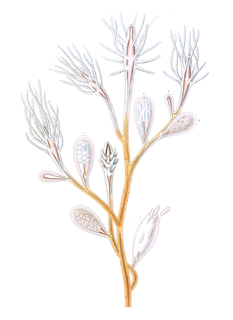
The orange-footed sea cucumber is the largest sea cucumber in New England, United States. It is one of the most abundant and widespread species of holothurians within the North Atlantic Ocean and the Barents Sea (Russia), being most abundant along the eastern coast of North America.

Hydroidolina is a subclass of hydrozoans in the phylum Cnidaria. It contains the bulk of the paraphyletic "Hydroida" which were one of the main groupings of the class Hydrozoa in older classifications and were placed at order rank. Hydroidolina also includes, however, the highly advanced colonial jellies of Siphonophora, which were not included in the "Hydroida".

Leptothecata, or thecate hydroids, are an order of hydrozoans in the phylum Cnidaria. Their closest living relatives are the athecate hydroids which are similar enough to have always been considered closely related, and the very apomorphic Siphonophora which were placed outside the "Hydroida". Given that there are no firm rules for synonymy for high-ranked taxa, alternative names like Leptomedusa, Thecaphora or Thecata, with or without the ending emended to "-ae", are also often used for Leptothecata.

Rhopalonematidae is a family of hydrozoans. The family comprises 15 genera and 36 species.

Haleciidae is a family of hydrozoans. Their hydroid colonies emerge from a creeping hydrorhiza and usually form upright branching colonies, although some species' colonies are stolonal. Their gonophores are typically sporosacs, growing singly or bunched into a glomulus. They remain attached to the hydroids or break off to be passively drifted away; in a few, the gonophores are naked.
Csiromedusa medeopolis is a species of hydrozoan described in 2010. It was discovered in the estuarine waters of the River Derwent near to the Commonwealth Scientific and Industrial Research Organisation's Marine and Atmospheric Research branch in Hobart, Tasmania, Australia. C. medeopolis has been described as presenting a new family and genus as well as species.

Bougainvillia muscus is a marine invertebrate, a species of hydroid in the suborder Anthomedusae.

Oceaniidae is one of the over 50 cnidarian families of the order Anthomedusae. It contains nearly 50 species in ten genera.
Solmarisidae is a family of hydrozoans in the order Narcomedusae. The name is sometimes spelled "Solmaridae".

Bougainvillia is a genus of hydroids in the family Bougainvilliidae in the class Hydrazoa. Members of the genus are characterised by having the marginal tentacles of their medusae arranged in four bundles. Some species are solitary and others are colonial but all are filter feeders. They are found in the Southern Ocean, having a circumpolar distribution, but some species also occur in the Northern Hemisphere, possibly travelling there as polyps on the hulls of ships.

Tubularia indivisa, or oaten pipes hydroid, is a species of large hydroid native to the northeastern Atlantic Ocean, the North Sea, Norwegian Sea, and the English Channel. The conical solitary polyps are found on dull yellow unbranched stems that reach 10 to 15 cm in height with a diameter of 1.5 cm (0.59 in). They may be fused to a small number of other individual stems at their bases. The pinkish to red polyps resemble flowers, having two concentric rings of tentacles, with the outer rings being paler and longer than the inner ring. At the center is a pale pink gonotheca. They are preyed upon by nudibranchs.

Hydractiniidae is a cnidarian family of athecate hydroids.
Bougainvillia aberrans is a marine invertebrate, a species of hydroid in the suborder Anthomedusae. It was first described by Dale Calder in 1993. They have four radical clusters of marginal tentacles. Bougainvillia aberrans is found in Bermuda in the western North Atlantic Ocean.
Bougainvillia crassa is a marine invertebrate, a species of hydroid in the suborder Anthomedusae. It was first described by Frassa in 1938.

Solanderia is the sole genus of hydrozoans in the monotypic family Solanderiidae. They are commonly known as tree hydroids or sea fan hydroids.

Porpita prunella is a marine species of hydrozoan organisms within the family Porpitidae. It consists of colonies of zooids. Very little is known about this species, as there have been no confirmed sightings since its discovery in 1801 and naming by Haeckel in 1888. Being in the chondrophore group, it is likely that its behaviour is similar to the other species of the genera in the family. However there are also serious doubts as to its very existence as a separate species and may in fact be a synonym for Porpita porpita instead.

Filifera is a suborder of hydrozoans in the order Anthoathecata. They are found in marine, brackish and freshwater habitats.

Cordylophora is the sole genus of hydrozoans in the monotypic family Cordylophoridae.
The Latin word frondosa is the species name of many unrelated fungi, plants, and animals that have a frondose shape.
Paracoryne is a monotypic genus of cnidarians belonging to the monotypic family Paracorynidae.












